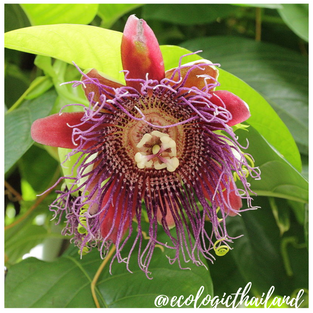Giant Granadilla | Badea
- Eco-Logic Resort
- Dec 4, 2020
- 3 min read
Sukhontharot | สุคนธรส | Passiflora quadrangularis
Family: Passifloraceae - Genus: Passiflora

The fruit and it's beautiful flowers can be found at the hydro aqauponic greenhouse on the premises of TCDF and near the entrance of the Food Forest Kitchen Restaurant of Eco-Logic Thailand.
Giant Granadilla is a fast-growing tropical vine with fleshy tubers. It can be up to 15m long. The tendrils are pale green, coiled in a spiral, and not branched. The leaves are large and green or purple. The flowers are scented, occur singly, white and purple, and characterized with red dots.
The fruits are greenish yellow and comprised with black seeds. It is the largest fruit in the Passiflora genus.
The fruit is edible, often eaten raw when ripe, cooked, or made into drinks. Immature fruits are used as a vegetable. Roots of old plants are baked or roasted.
In South-East Asia fruit is available throughout the year. Flowers are produced 9 months from planting and ripe fruits are harvested 60-80 days later. A vine produces 16-50 fruits per season.

THE PLANT
It is a vigorous, tender evergreen perennial climber with beautiful flowers and a large, oblong fruit.
The vine is fast-growing, large, coarse, herbaceous but woody at the base, climbing trees to a height of 10-15 meter.

THE LEAVES
The alternate leaves are broad-ovate or oblong-ovate, 8.25-15 cm wide, 10-20 cm long; with conspicuous veins sunken on the upper surface, prominent beneath.
A tea can be made from the leaves which is used for high blood pressure and diabetes.

THE FLOWERS
The solitary, fragrant flowers, up to 12-12.5 cm wide, have a bell-shaped calyx, the 5 sepals greenish or reddish-green on the outside, white, pink or purple inside; the 5 petals white-and-pink; the corona filaments 2-rankedpurple-and-white below, blue in the middle, and pinkish-blue above.
There is main flowering season towards the end of the rainy season.

THE FRUIT
It has a large, oblong fruit, containing numerous seeds, embedded in a sub-acid edible pulp, very similar to passion fruit
The pleasantly aromatic, melon-like fruit is oblong-ovoid, 12-15 cm wide, and 10-30 cm long; may be faintly ribbed; has a thin, delicate skin, greenish-white to pale- or deep-yellow, often blushed with pink.
Beneath it is a layer of firm, mealy, white or pink flesh, 2.5-4 cm thick, of very mild flavor, and coated with a parchment-like material on the inner surface.
The central cavity contains some juice and masses of whitish, yellowish, partly yellow or purple-pink, sweet-acid arils (commonly referred to as the pulp), enclosing flattened-oval, purplish-brown seeds to 1/2 in (1.25 cm) long.
CULINARY USES
A tea is made from the leaves which is used for high blood pressure and diabetes. A drink and ice-cream are made from the fruit.
The flesh of the ripe fruit, with the inner skin removed, is cut up and added to papaya, pineapple and banana slices in fruit salads, seasoned with lemon or lime juice. It is cooked with sugar and eaten as dessert, or is canned in sirup; sometimes candied; but it is so bland that it needs added flavoring.
The immature fruit is used as a vegetable - it can be steamed or boiled or added to soups.
The thick rind of the fruit is cooked in various ways and used as a vegetableT
Jelly can be made from the unpeeled flesh boiled for 2 hours and the pulp simmered separately. The juice strained from both is combined and, with added sugar and lemon juice, is boiled until it jells.
The pulp (arils) yields a most agreeable juice for cold drinks. The whole arils can be eaten raw without removing the seeds.
NUTRITION
The serving size of 100 grams of Giant Granadilla fruit grants 78.67% of vitamin C, 10% of iron, 2.44% of phosphorus, 2.36% of Vitamin B3, 1.38% of calcium.
MEDICINAL USE
NOTE: please take advice from a doctor if you are planning to use herbal medicine.
ROOTS AND LEAVES: Medicinally, the root and leaves are used as a soothing poultice for the treatment of liver problems. The fruit, on the other hand, is used in the treatment of headaches, asthma, diarrhea, dysentery, neurasthenia, and insomnia.
The seeds contain a cardiotonic principle, are sedative, and, in large doses, narcotic. The leaf decoction is a vermifuge and is used for bathing skin afflictions. Leaf poultices are applied in liver complaints. The root is employed as an emetic, diuretic and vermifuge. Powdered and mixed with oil, it is applied as a soothing poultice.
FRUIT: The fruit is valued in the tropics as antiscorbutic and stomachic. It is said to be used as a sedative to relieve nervous headache, asthma, diarrhea, dysentery, neurasthenia and insomnia.
INTO THE WILD: a down to earth experience

For guests and visitors to Paksong we organize weekly tours "The Edible Forest" and Foraging weekends: Into the Wild. We work with local guides to take you in the jungle of Paksong. After foraging, we will cook a meal with the ingredients, using bamboo together with you!
Come and join and learn about the abundance of food that nature gives us!
INTO THE WILD!


















Comments